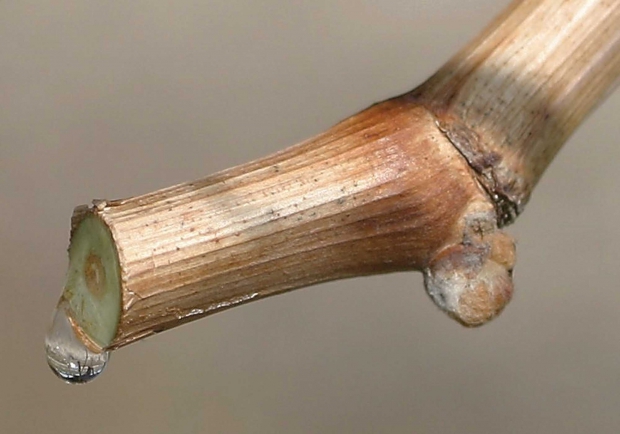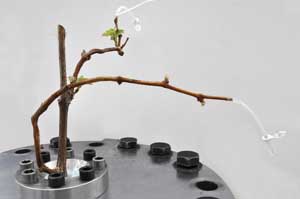
Sap flow, or bleeding, is a good thing in your vineyard in early spring. Washington State University
Even a two-week delay in filling up the soil profile in early spring when vines begin to break bud can reduce cluster counts and impact yields, according to Washington State University scientists.
In recent years, WSU researchers have shown the importance of adequate soil moisture during bud break and the connection between bleeding or sap flow and bud break. Dr. Markus Keller, WSU horticulturist who specializes in grapevine physiology, and his colleague Dr. Bhaskar Bondada used potted Merlot vines to show the link between soil moisture and delayed bud break, reduced shoot growth, and reduced fruit set. (See “Irrigate early if winter is dry,” Good Fruit Grower, February 15, 2013.)
After the dry winter of 2005—when the Pacific Northwest received less than half of normal precipitation—many Washington vineyards had stunted shoot growth and crop losses of up to 50 percent. The recent winter in Washington was one of the warmest and driest (in terms of snowpack) in a decade.
Dr. Hemant Gohil, former technology transfer specialist at WSU who is now grape and tree fruit extension educator at Rutgers University, was part of a recently concluded four-year bud break study. While at WSU, Gohil looked at the impact of the timing of early-season irrigation on fruit set and shoot growth in wine grapes.

Hemant Gohil
“There’s not been a lot of published research on the subject of soil moisture and bud break,” Gohil told Good Fruit Grower before he left for Rutgers.
Lack of moisture in spring is not a problem in many parts of the wine grape-growing world. But in Washington, the majority of wine grapes are produced on the eastern side of the Cascade Mountains, a unique region that typically receives less than ten inches of precipitation annually.
During the first few years of the study, WSU scientists proved that the relationship between soil moisture content and subsequent plant development is real, said Gohil.
In the final year of the study, Gohil looked at the impact of delaying early spring irrigation by two, four, and six weeks during bud break with different soil moisture gradients.
He used potted Merlot vines to compare four early irrigation treatments in both sandy loam and loamy sand soil textures. Treatments were: no delay in irrigation in early spring (soil profile was kept at field capacity) and early spring irrigation delays of two, four, and six weeks. In the delay treatments, soil profiles were kept at permanent wilting point for the two-, four-, or six-week treatment period and then irrigated normally.
Soil moisture levels were tested at various intervals between field capacity (when soil has the maximum amount of water it can hold without losing any water to deep percolation or runoff) and permanent wilting point, when plants have limited ability to extract water from the soil.
Delays are costly
Delaying irrigation by two weeks in early spring at bud break can make a big difference in yield later that season, according to Gohil. “We found that vines can catch up in terms of shoot and vegetative growth from the two-week delay, but there’s no catching up in the number of flowers and clusters.”
Preliminary data showed that vines in sandy loam soil had a 25 percent yield reduction from the two-week delay treatment.
“In the loamy sand treatments, yield differences between no delay and the two-week delay were not statistically significant, but there was huge variation in yield within the two-week delay treatment,” he said, adding that the range of yield within the same treatment was unusual and indicates some replicates were impacted by the delay of soil moisture.
Gohil found there’s a fine line in the soil moisture needed for uniform bud break and strong shoot growth. Uneven bud break results in uneven canopy development and non-uniform berry and cluster development and ripening.
“If your soil is at 4 percent or just below field capacity at bud break, you need to irrigate immediately,” he said.
Additionally, when vines were maintained at slightly higher soil moisture levels of 2 percent below field capacity during the two week delay, it wasn’t enough to significantly improve fruit set and shoot development from the 4 percent field capacity treatment.
Even more dramatic were differences observed in the four-week delay treatment. “A delay of four weeks resulted in decreased flower set and cluster numbers and stunted shoot growth,” he said. Irrigating that far behind the curve is probably too late, he added. The six-week delay was even worse—most vines didn’t have clusters, and vines that managed to grow were very stunted.
When to irrigate
“So the time to irrigate—if you’ve had a dry winter and soil moisture is below field capacity—is within a week of bud break,” he recommended.
How do you know if irrigation is necessary or when bud break will start?

Sap flow was collected from grapevines as part of a Washington State University research project.
Hemant Gohil
Previous research found shoot growth and sap bleeding rates are strongly correlated with soil moisture. Sap commonly bleeds through pruning cuts in early spring as a result of positive root pressure and is an indicator that vineyard soil moisture content is adequate, so look for sap flow.
But if you don’t see bleeding or sap flow when soil temperatures begin warming above 45°F and air temperatures are above 50°F, irrigation is needed quickly, says Gohil.
“If there’s a lack of or spotty sap flow, the earlier you irrigate the better,” he said. For some, that may mean pumping from a pond or well if irrigation district water is not yet available.
Additionally, growers need to remember that varieties bleed and break bud at different times. Chardonnay is an example of a variety that breaks bud early. “Early maturing varieties tend to break earlier than later ones,” said Gohil.
Gohil stressed that growers need to know their vineyard soil moisture levels before the season starts and look for visual signs, like sap flow, to indicate adequate soil moisture or use soil moisture monitoring devices. •






Leave A Comment